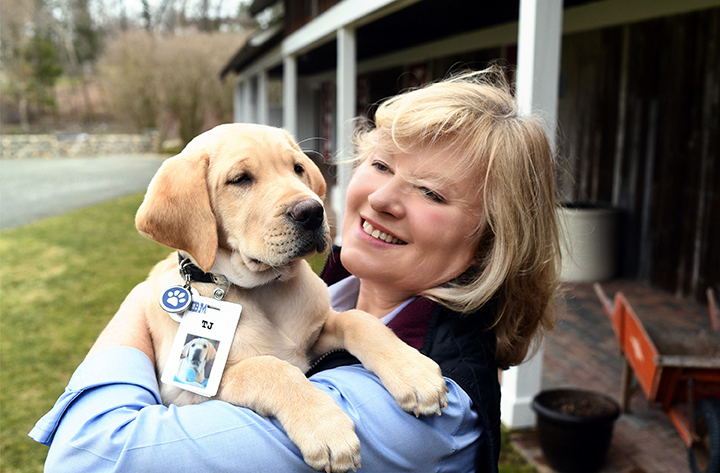IBM Watson
How Watson is Helping More Puppies Become Guiding Eyes for the Blind
July 27, 2017 | Written by: Lorraine Trapani
Categorized: IBM Watson
Share this post:
Guide dogs help to provide people with vision loss with independence, safety, and, perhaps equally important – companionship. These puppies with a purpose change lives for the better in many, many ways. I volunteer as a puppy raiser for Guiding Eyes for the Blind because I saw first-hand how my late husband’s vision loss affected him during his battle with cancer. I want to help make lives better for people who are blind or have impaired vision.

IBM’s Lorraine Trapani holds TJ. (Photo: Darryl J Bautista/Feature Photo Service)
Guiding Eyes for the Blind is a non-profit organization dedicated to the breeding, raising, training and placement of guide dogs with people who are blind or visually impaired. Guiding Eyes is using Watson to help pair more guide dogs with those who need them.
The stakes are high: each dog costs Guiding Eyes approximately $50,000 to train over two years, and only half of the dogs raised and trained will graduate as guide dogs or be chosen as dogs to breed. Of all puppies bred at Guiding Eyes, 37 percent eventually become guide dogs and another 13 percent are provided to other organizations to succeed in less demanding service dog work. Guiding Eyes is using Watson in its quest to further improve the process and increase the success of its program.
CBS Evening News: Watson helps determine which puppies can serve the blind
By using Watson on the cloud, Guiding Eyes has analyzed 500,000 medical records and 65,000 records about dog temperaments, matching characteristics and personality traits of trainers with dogs’ temperament, medical and genetic data. Based on a sample of 105 guide dogs, Watson has been able to predict with 100 percent accuracy which guide dogs would successfully graduate from Guiding Eyes’ training.
As a volunteer, I receive the puppies at 8 weeks of age and spend about a year raising them at my home in Ridgefield, Conn. Then the puppies go back to Guiding Eyes to be professionally trained in guide work — a process that typically takes about six months. Sometimes, dogs receive additional training to assist with multiple challenges. The first puppy that I raised, Merrick, was trained to work with a deaf and blind person. Ed, another puppy that I raised, is working as a guide dog for a man whose family includes five daughters.
Merrick and Ed are among the more than 7,000 guide dogs that Guiding Eyes for the Blind has trained since 1954 to help people with vision loss gain greater independence by being paired with a guide dog. My new puppy, TJ, is named after IBM founder’s T.J. Watson, and is the sixth puppy I’ve raised.
To expand the scope of factors that Watson can take into account, Guiding Eyes and IBM are working with researchers at North Carolina State University to tackle the challenge of dog stress, one of the most difficult traits to measure and among the biggest predictors of a dog’s ability to graduate from the Guiding Eyes training program and work with people.
Researchers are developing wearable devices equipped with sensors to measure behavior and heart rate level of puppies that measure how puppies vary in their emotional response to potentially stressful situations. These “Internet of Things” devices can enable more effective breeding, raising and training for the puppies to become guide dogs.
In the U.S., someone becomes blind every seven minutes, and as the “Baby Boomer” generation faces age-related vision loss, the demand is increasing. Ultimately, the Guiding Eyes and Watson partnership will increase graduation rates to help meet the growing demand for guide dogs.
Watson represents a new era in computing called cognitive computing, where systems understand the world in a way more similar to humans: through senses, learning, and experience. Watson continuously learns from previous interactions, gaining in value and knowledge over time. With the help of Watson, organizations are harnessing the power of cognitive computing to transform industries, help professionals do their jobs better, and solve important societal challenges.
___________________________________
Related:
THINK Blog: How Technology Levels the Playing Field for the Blind
Donate Today: www.guidingeyes.org

Supply Chain Compliance Manger, IBM
Making the workplace safe for employees living with HIV
The recent promising news about Covid-19 vaccines is in sharp contrast to the absence of a vaccine for HIV, despite decades of research. Unlike Covid-19 with a single viral isolate that shows minimal diversity, HIV circulates in a wide range of strains that so far have proven impervious to a single vaccine. Fortunately, more people […]
Call for Code for Racial Justice Needs You: Join the Movement
IBM has never avoided taking on big challenges. At IBM, we are privileged to drive impact at scale. We take on challenges that transform our clients, impact people’s lives and innovate for future generations as we strive to effect systematic societal change. Over the course of our 109-year history, the evidence has become clear that […]
A New Wave: Transforming Our Understanding of Ocean Health
Humans have been plying the seas throughout history. But it wasn’t until the late 19th century that we began to truly study the ocean itself. An expedition in 1872 to 1876, by the Challenger, a converted Royal Navy gunship, traveled nearly 70,000 nautical miles and catalogued over 4,000 previously unknown species, building the foundations for modern […]


